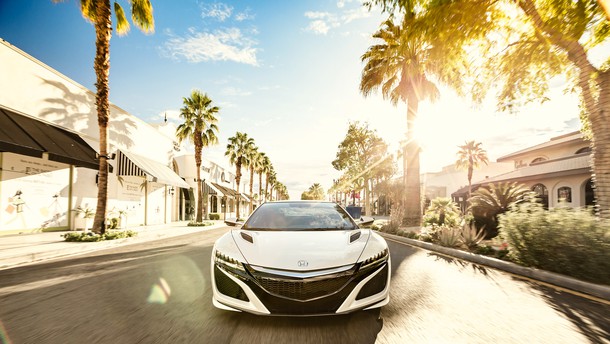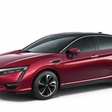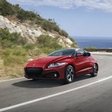
Who needs a flux capacitor for time travel? You don't have to be Marty Mcfly for that, or Emmet L. Brown, and you don't have to be Doc or fine-tune a DeLorean, for that matter. Above all, you don't have go to the movies--a visit to your nearby Honda dealership will suffice. But beware, your ticket to travel through time will not cost you 8 Euros...try 180,000 Euros. Starting this fall, that lump sum will buy you a time machine that really will beam you back to the future. Exactly 25 years after the presentation of the groundbreaking NSX, Honda finally lined up the second generation at the starting gate, which will raise the bar for super sports cars.

Developed to shake up both of its brands with adrenaline and emotions, in the 80s, Honda equipped its New Sportscar eXperimental with technology borrowed from Formula 1, and registered over 400 patents. Even then, the car boasted an electronic accelerator, a titanium connecting rod, platinum spark plugs, and bodywork and a chassis largely made of aluminum. Buyers were much more drawn to the exquisitely-sharpened lines, initially amped with an attractive accessory, in the form of pop-up headlights, which put the NSX in the ring, visually at least, with Ferrari and other super sports cars. Moreover, the Japanese manufacturer offered equipment and work space that none of the Italian sports cars back then could duel with. The Honda NSX thus came with factory-installed automatic air-conditioning, leather seats, air bags, a CD player and electric windows. Aside from that, the car also enjoyed the reputation of being extremely reliable. While other super sports cars spent a lot of time on pneumatic lifts, many NSXs covered over 200,000 kilometers, without a problem.

It comes as no surprise that we drove a sports hybrid (and more eco-friendly) Honda NSX across central California. Over many decades, this state has been a harbinger of progress in the automobile industry, (sooner or later) followed by the rest of the world.
Although air quality was never an issue for Palm Springs, which can't be said for Los Angeles, the story that started to be written in the 60s was no less important for this little town. It's only a question of what it would've been like, had California not passed the very first regulation on vehicle exhaust, in 1966, and witnessed the foundation of the California Air Resource Board (CARB), which has been making sure that vehicles are ecologically-sound, and improving in that direction from year to year. CARB strove to minimize the sulfur and carbon content in fuels, as well as reducing CO2 emissions, and made catalytic converters mandatory. Why were the first electric vehicles sold in California, and why is that state the home of hybrids? Because CARB fought for regulations in California, and has been ahead of the other states, although some American presidents, including George H. W. Bush, tried to halt progress. California, however, was the first state in the country to limit emissions of nitrogen oxides, reduce lead content in gasoline, and require cars to monitor their emissions, setting vehicles with low or even zero emissions as a new standard.

California, the land of clean vehicles
The 1990 ZEV program (Zero Emissions Vehicles) foresaw that such cars would comprise 2% of the population of Californian roads by 1998, with the percentage rising to 10 by 2003. Because technology did not progress quite as quickly as they had envisioned, the regulation changed over the years (in the end, the requirement for 2003 landed at 2% for electric vehicles and 6% for conventional vehicles with very low emissions). They required car brands to hold environmental certifications that were adapted to their sales figures and range of cars, but the manufacturers could meet these requirements with a different mix of electric, hybrid and conventional vehicles.

Toyota. The spirit was simply not there anymore, admits Yousuke Sekino. The company was like a dormant volcano from prehistoric times, still radiating from within, philosophized the head of the project. And everybody had given up on the idea that it would ever erupt again. Everybody, except for Sekino, who was right in the end. Lava flowed again and set the slopes on fire and, after ten long years, Sekino can once again danced atop the volcano.
Sekino and his top engineer, Ted Klaus, took their time, some of which was also squandered, due to the economic crisis and the Fukushima nuclear disaster, and partly because "they wanted to do everything right," says Klaus. Defined as New Sportscar Experience, the NSX was to be released in a version based on the muscular V10 bolide, but since the car had barely anything to show off, the project was aborted and launched all over again, this time with different developmental plans.

The technology has indeed moved on and, aside from the low, wedge-shaped form, the new NSX has, stylistically, nothing in common with its predecessor. Though the idea behind both of them, despite their age difference of 25 years, is still the same, says Klaus. "The car must fit the driver like a second skin, and its only job is to make him faster."

As a result, the Japanese went overboard by constructing easily the most powerful drivetrain in its class. The new turbocharged 3.5-liter V6 gas engine, with 507 hp and 550 Nm torque, roars beautifully from beneath the rear windshield, works with the electric motor, with 48 hp and a torque of 148 Nm, in order to overcome the turbo lag and lower the consumption. Two additional electric motors up front each power a front wheel with 37 hp and 74 Nm torque. That amounts to a system output of 581 hp and a torque of 698 Nm, and a performance at the level of Ferrari. It will dash to 100 km/h in less than three seconds, and it will peak at 307 km/h, which should be enough to qualify for the club of super sports cars. Even though, according to Klaus, the basis for high performance hides in the drivetrain, the battery packaged under the passenger's seat must also make a difference, in terms of fuel consumption: 10.4 liters for a sports car of this caliber is not at all bad.
Yet, the official estimates proved inconsistent with the real-time impressions. Theoretically, the NSX is in the same league as the Audi R8, Porsche 911 or Ferrari 488, but in practice, it floats in another dimension, thanks to its drivetrain concept. Searching for a perfect line through a corner, other car manufacturers apply braking to individual wheels, in order to preserve power from tire squealing, while also maintaining the side drift, whereas the NSX's electric motors on the front wheels apply torque individually and, at times, in the opposite direction, which makes it conquer corners faster. The steering becomes a memory game, where skidding can be easily corrected, the driver accelerates faster and applies the brakes later. Most of all, the driver has the feeling of speeding along like Aryton Senna, who collaborated on the development of the very first NSX. And in spite of very complex computational procedures, which were probably developed by NASA for a mission to Mars, everything seems incredibly obvious, genuine and intuitive. As absurd as this may sound, after only a few curves, you no longer think about the drivetrain.

The roads through the hills that surround the Coachella Valley and the famous city of Palm Springs, are a perfect fit for the NSX. A mixture of slow and fast curves, carved into the rocks every now and then, allows the driver to enjoy its ease of operation, as well as the echoing or amplified roar of the engine. Pulling in to an unpaved rest area unveils a view over the valley and thousands of wind turbines, that provide electricity far and wide. Thanks to the excellent traction on the otherwise rough asphalt, the ride through the curves towards the city streets, lined with prestigious stores, is nothing short of a superior experience.
The overall feel of the car, as it was announced by Klaus with the arrival of the new NSX, can be detected in the super rigid bodywork that employs new materials and procedures to draw closer to a monocoque made of carbon fibers. The new structure, which is actually made of light aluminum, utilizes a space frame design. The most strategic points are reinforced by ultra-solid steel and carbon fibers. The frame is comprised mostly of aluminum corner profiles, welded by the robots. "Because of its unmatched torsional rigidity, the NSX directly responds to the driver's cornering demands, without losing the connection between front and rear axles," Klaus explains.

If, today, Honda is richer for the experience of a new sports car, and is thus relying on electric traction, electronic controls and high-tech bodywork, then the production of the first NSX needed just that--experience. Ahead of its time even then, the car starred an aluminum bodywork and weighed a total of 1400 kg. But, by today's standards, its 3.0-liter V6 with 274 hp seem slightly underpowered. Thanks to one of the most prominent test drivers of all time, Formula 1 legend Ayrton Senna, the car sold 20,000 units in around 15 years, and was considered the first car from the Far East to kill Ferrari. Senna, who also raced in the Honda bolides, helped develop and tune the Honda NSX. We have him to thank for the NSX's ease of everyday use as a sports car, much easier to control then the Italian divas of the day. This is just as much the case today, if not more so: you don't need to be Ayrton Senna to drive like a Formula 1 star. "With our drivetrain concept on a winding road or track, even normal drivers reach unimaginable speeds. And professionals break all the barriers," Klaus promises.
The NSX is a new generation sports car which anyone will appreciate, not only those who sit behind the wheel. With little clearance, the car grabs the road like some invisible bomber. Its shape is a result of tests in a wind tunnel, which improved upon its aerodynamics and air flow, to accommodate all 10 coolers. Four LEDs in the headlights, and four central exhausts, refuse to be decorative. The echo of modesty can be heard, especially when the driver turns on "Quiet" mode in the morning, and drives through the neighborhood with at speeds of up to 100 km/h on electricity alone. "You don't want your neighbors to become your enemies," says Klaus. It may be enough if the rest of the sports community gives you the hairy eyeball. Used to the Italian and German rivals, which seem outdated by comparison, and with the Porsche 918 and BMW i8 too exotic to be points of comparison, sports car owners won't be singing the praises of your NSX.

Lack of plug-in technology and significant differences in performance and price aside, there is no other car that can stand up to Porsche 918 like this Honda can. Nowhere else will you feel closer to the future than in this combination of an Audi R8 and a BMW i8. If Marty McFly and Doc Brown had another chance to travel back to the future, they'd have to leave their DeLorean behind and drive off with the Honda NSX.
Officially, the NSX belongs to the Honda brand, and though the team consisted of some Japanese members, it was the Americans who were in charge of its development. Most buyers come from America, a trend that is probably not going to change. Besides, the car will be manufactured in the USA, in Ohio, to be precise.

To Sekino, the project manager, that's as much of a blessing as it is a curse. A blessing, because the Americans developed a stunning sports car that is well ahead of its rivals, while also showing BMW what the i8 sports car is truly supposed to look like. And a curse, because the Ohio facilities can manufacture exactly 8 cars per day, meaning that the newly-awakened sports spirit must be shipped back to Japan. For Sekino, that's where the challenge begins, since expenses will barely be covered with 1500 cars per year: "With the premiere of the new NSX, we haven't yet crossed the finish line, but we've only just started."



